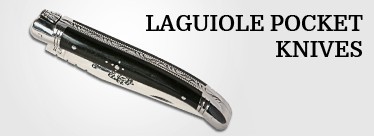Handmade knives – Laguiole Actiforge knife

Handcrafted knives
Our production is hand-crafted which distinguishes it from industrial production.
Manufacturing and assembling a knife requires more than one hundred operations performed by the craftsman’s hand. Each step is done by Master craftsmen who control the quality of their work at each stage of the process.
The materials used are of French origin.
Blades
The blades are made of stainless steel 12C27,or should you request it, made of carbon steel. That steel is cut out through pressing
They are punched with our brand.
The blades undergo thermal treatment which is done in two steps.
Tempering: The blades are heated up to 1030 ° and cooled down suddenly in order to give hardness to the metal.
Heat treatment: The blades are once again warmed but cooled down slowly which gives flexibility to the steel. The hardness obtained is 52/54 Hrc
The shaping of the cutting edge is provided to the blade by grinding, to ensure them a perfect cutting edge.
The blades are given perfect planarity.
They are then polished.
Plates
Knife plates are made of brass or stainless steel.
They are the backbone of the knife. They provide rigidity and strength to the binding of the sides of wood or horn.
These plates can have bolsters made of solid brass or forged steel.
The front bolster supports the hinge axis of the blade.
The back bolster protects the handle against shocks.
Spring
Forged Bee
The spring and the bee are forged as one piece.
The ornaments, character engravings are made at this stage because the steel has not reached its final hardness.
It is then heated in an oven at a temperature of over 1000 ° and tempered. After tempering, it is covered with calamine. It is polished once.
Welded bee
The Bee is welded into the spring.
It is then heated in an oven at a temperature of over 1000 ° and tempered. After tempering, it is covered with calamine. It is polished once.
Fly or bee?
The end of the spring bears a flat part, the fly (technical cutlery term). The first Laguiole knives had no decoration. Later, flies were decorated with a bee. It became a symbol of the Laguiole knife.
The bladestop
The bladestop is a small piece of metal which is placed into the locking mechanism in order to protect the blade from the shock This prevents the blade from dulling when the user snaps it shut too fast.
Handles
Laguiole knife handles are hand crafted. A thin cross-shaped nailing decorates the handle . This is the shepherd's cross. Indeed, according to the legend shepherds prayed with this religious symbol when they were isolated in the mountains.
Horn or bone handles
The first Laguiole knives had handles made of bone or horn, the materials which were the most readily available at the time.
Bone looks like ivory. It becomes lightly yellow in the time.
Just like hair colour, bone colour can vary. You can find blond or black horn.
Although this material provides a wide range of natural colors and patterns, there is a great difference in quality between the material taken from the tip of the horn, and the lower hollow section
- Tip of horn: only the tip of the cow’s horn is used
- Pressed horn: The lower hollow section of the horn is used
Wooden handles
Very early on, wood completed the choice of materials for knife handles.
Only very hard woods are suitable. The high shine of the handle is achieved by patiently polishing it through soft and gentle rubbing.
Wooden handles are never varnished.
The types of wood used include the following precious wood species:
Ebony, olive, rosewood, kingwood , snakewood, stamina wood, wenge. Please note that handles made of wood and horn are not water-resistant. Therefore they are not safe in the dishwasher.
Handles made of Plexiglas
Plexiglas is extremely water-and heat-resistant.
The plates are all hand-shaped as in the case of horn plates. Plexiglas has the tremendous advantage of being dishwasher-safe.








